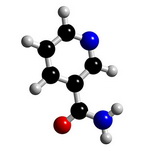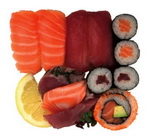|
Niacin – Not Considered A True VitaminNiacin also known as vitamin B3 has two components, nicotinic acid and nicotinamide. The vitamin was first oxidized from the nicotine from tobacco; however, nicotinic acid is not the same and not closely related to the nicotine molecule. Like other B vitamins, B3 is a coenzyme that is involved in over 200 metabolic processes. It is not considered a true vitamin since it can be derived from the amino acid tryptophan.
Niacin Molecule
The coenzymes of the vitamin are crucial in the production of the energy molecule ATP (adenosine triphosphate) which is a fuel that cells use to create molecules, contract muscles, transport substances throughout the body and to perform numerous other tasks in the body; therefore vitamin B3 is a key player in the production of energy. Dietary Recommendations The intake recommendations are in niacin equivalents (NE), which includes the dietary sources as well as the sources derived from tryptophan. Thus, the RDA (recommended dietary allowance) for adult men of all ages is 16 milligrams/day NE, the RDA for adult women of all ages is 14 milligrams/day NE. For women who are pregnant it increases to 18 milligrams/day NE and for women who are lactating it increases to 17 milligrams/day NE. Vitamin Sources The vitamin is unique because it can be synthesized from the amino acid tryptophan as well as obtained from food. The primary dietary sources of the vitamin are meat, poultry, fish, enriched and whole grain breads and grain products, and fortified ready to eat cereals. Other good dietary sources are liver, mushrooms, peanuts, and sea food. A good thing about the vitamin is that it is stable during cooking and tolerates heat well, so conventional methods of cooking will not destroy the vitamin.
The vitamin precursor tryptophan is found in animal foods that are protein rich. The conversion from tryptophan to the vitamin requires other nutrients such as riboflavin, vitamin B6, and iron. Sources of Vitamin B3
Vitamin Deficiency One sign of a dietary deficiency of the vitamin is the disease pellagra with symptoms of redness around the necks of people with the disease. The disease is a very serious one with the symptoms of dementia, diarrhea, dermatitis, and in extreme cases death. Vitamin Toxicity Toxicity results in side effects such as flushing, itching, and tingling.
For other information on nutrition, and vitamins in particular some great references are: • Nutrition – Fourth Edition by Paul Insel, Don Ross, Kimberley McMahon, and Melissa Bernstein
Vitamins
|







